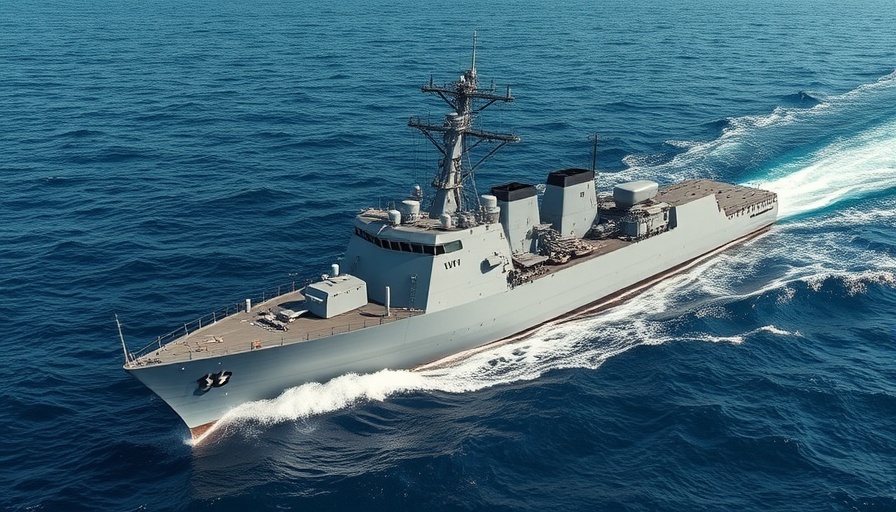
The Life Aboard USS Thomas Hudner: An Insider's Experience
Recently, I had the unique opportunity to spend a night aboard the USS Thomas Hudner, a combat-tested US Navy destroyer, as it journeyed from England to France. This excursion provided a fascinating glimpse into the daily lives of the sailors who dedicate their lives to serving aboard this robust vessel.
Understanding the Ship's Purpose and Crew Roles
As the commanding officer, Cmdr. Cameron Ingram underscored the importance of teamwork in maintaining the ship's operations. With over 300 sailors aboard, each person embodies a crucial role—be it as a lookout, maintenance worker, or performing tasks like laundry. From navigation to combat readiness, every sailor contributes to what Cmdr. Ingram aptly described as a "big complex machine." Life aboard a destroyer is not merely about operating state-of-the-art technology or weapons systems; it's also about community and camaraderie. Each sailor relies on their teammates to perform their jobs effectively. As I observed the crew manning rails and working together seamlessly, the sense of unity became palpable.
A Snapshot of Daily Life on the Ship
Our evening began in the wardroom, where meals are shared, and camaraderie flourishes. Dinner that night featured pizza, pasta, and Brussels sprouts—the kind of meal that fosters casual conversations among the officers. While we dined, the audacious battle scenes from "Saving Private Ryan" played in the background, echoing the ship's purpose of commemorating significant events like the D-Day invasion.
Such films serve as reminders of the sacrifices made by those in the military and the historical significance surrounding the crew's presence in the English Channel. It is a powerful way for the sailors to connect with their history and their current mission.
The Challenges of Life at Sea
While the notions of valor and brotherhood abound aboard a destroyer, life at sea also brings its set of challenges. The living conditions are different from civilian life, with tight passageways and shared sleeping arrangements. Maintaining personal space is difficult, yet sailors learn to embrace the shared environment. This adaptation reflects a broader lesson in collaboration and resilience—qualities essential for soldiers navigating the challenges of military service.
Moreover, the ship's operational tempo means that downtime is scarce. Sailors are often on watch, even when they have a moment to themselves, always aware of their responsibilities. The psychological toll is a reality for many service members, punctuating the importance of both physical and mental health care while at sea.
The Thrills of Navigating at Sea
As the USS Thomas Hudner sailed away from Portsmouth, two tugboats gently maneuvered it into the harbor, with sailors in their dress blues standing by. There's something captivating about witnessing a destroyer navigate crowded waterways, a testament to the training and precision that defines naval operations.
This journey across the English Channel—so intertwined with historical significance—was particularly poignant. The ship itself bore kill marks from previous encounters, a stark reminder of its ongoing relevance and mission readiness. Every wave and movement brought alive the stories that ripple through time, linking this modern warship to centuries of naval history.
Reflections on the Future of Naval Operations
As we approach future conflicts and challenges, understanding the lives of those who serve in the Navy becomes increasingly necessary. The sailors aboard ships like the USS Thomas Hudner exemplify not just courage but also adaptability in the face of evolving technologies and warfare strategies. The training they undergo equips them for challenges that are both militaristic and those that stem from life aboard a ship.
Staying informed about military trends and innovations allows civilians to appreciate the complexities sailors face during deployments. Their stories are not only about battles fought on distant shores but also about pursuing personal growth and finding purpose, even when their missions shift amidst geopolitical changes.
In summary, spending a night aboard the USS Thomas Hudner revealed the blend of tradition and modernity essential to naval operations today. It is a lifestyle characterized by sacrifice, dedication, and an unwavering commitment to serve. As we honor those who have fought for freedom on these vessels, we must also support the ongoing evolution of military strategy and operations in our contemporary world.
As we reflect on their sacrifice and commitment, let us consider how we can support our troops and stay updated on relevant military developments. Knowing more about the experiences of our service members can create a deeper connection to their efforts and a greater appreciation for the complexities of military life.
 Add Row
Add Row  Add
Add 




 Add Row
Add Row  Add
Add 

Write A Comment